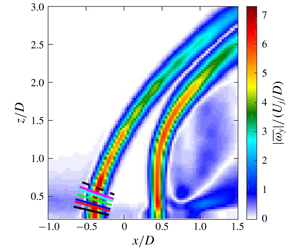Crossref Citations
This article has been cited by the following publications. This list is generated based on data provided by
Crossref.
Jia, Q.
Huang, L.
Zhu, Y.
Rashidi, M.M.
Xu, J.
and
Yang, Z.
2021.
Experimental research of active control optimization on a 3/4 open-jet wind tunnel’s jet section.
Alexandria Engineering Journal,
Vol. 60,
Issue. 2,
p.
2265.
Bansal, D.
Ghosh, D.
and
Sircar, S.
2021.
Spatiotemporal linear stability of viscoelastic free shear flows: Nonaffine response regime.
Physics of Fluids,
Vol. 33,
Issue. 5,
Harris, Elijah W.
Besnard, A.C.
and
Karagozian, A.R.
2021.
Effect of tabs on transverse jet instabilities, structure, vorticity dynamics and mixing.
Journal of Fluid Mechanics,
Vol. 918,
Issue. ,
de Souza, Davi B.
Freitas, Rômulo B.
and
de B. Alves, Leonardo S.
2021.
Criterion for the linear convective to absolute instability transition of a jet in crossflow: The countercurrent viscous and round mixing-layer analogy.
Physical Review Fluids,
Vol. 6,
Issue. 4,
Ren, Yukai
Yan, Hao
Cai, Cunkun
and
Ma, Tianshou
2022.
Numerical Study on Flow-Induced Noise of Deflector Jet Servo Valve Based on LES/Lighthill Hybrid Method.
Shock and Vibration,
Vol. 2022,
Issue. ,
p.
1.
Besnard, Andrea
Harris, Elijah W.
and
Karagozian, Ann R.
2022.
Asymmetric forcing of convectively unstable transverse jets.
Physical Review Fluids,
Vol. 7,
Issue. 6,
Lv, Yafei
Wei, Haipeng
Liu, Taotao
Zhao, Xin
Liu, Yuanqing
Huang, Biao
and
Wang, Guoyu
2022.
Numerical investigation of the round jet in crossflow at high velocity ratios with special emphasis on the evolution of vortex structures.
Physics of Fluids,
Vol. 34,
Issue. 3,
Nair, Vedanth
Sirignano, Matthew
Emerson, Benjamin L.
and
Lieuwen, Timothy C.
2022.
Combustion and flame position impacts on shear layer dynamics in a reacting jet in cross-flow.
Journal of Fluid Mechanics,
Vol. 942,
Issue. ,
Bansal, D.
Chauhan, T.
and
Sircar, S.
2022.
Spatiotemporal linear stability of viscoelastic Saffman–Taylor flows.
Physics of Fluids,
Vol. 34,
Issue. 10,
Gan, Ning
Liu, Yuanqing
Yao, Xiongliang
Chen, Yingyu
Ma, Guihui
and
Cui, Xiongwei
2022.
Experimental investigation on the development features of a gas jet on the surface of a vertical moving body with a constant volume chamber.
Physics of Fluids,
Vol. 34,
Issue. 8,
Harris, Elijah W.
Shoji, Takeshi
Besnard, Andrea
Schein, Stephen G.
M'Closkey, Robert T.
Cortelezzi, Luca
and
Karagozian, Ann R.
2022.
Effects of controlled vortex generation and interactions in transverse jets.
Physical Review Fluids,
Vol. 7,
Issue. 1,
Nair, Vedanth
Sirignano, Matthew
Emerson, Benjamin L.
and
Lieuwen, Timothy C.
2023.
Near-field evolution and scaling of shear layer instabilities in a reacting jet in crossflow.
Journal of Fluid Mechanics,
Vol. 960,
Issue. ,
Morse, Nicholas
and
Mahesh, Krishnan
2023.
Effect of tabs on the shear layer dynamics of a jet in cross-flow.
Journal of Fluid Mechanics,
Vol. 958,
Issue. ,
Harris, Elijah W.
Schein, Stephen G.
Ren, David D. W.
and
Karagozian, Ann R.
2023.
Synchronization and dynamics of the axisymmetrically excited jet in crossflow.
Physical Review Fluids,
Vol. 8,
Issue. 3,
Ding, Siyu
Li, Jiabin
Wang, Longfei
Ni, Chenxu
and
Wang, Xingjian
2024.
Flow Dynamics of a Dodecane Jet in Oxygen Crossflow at Supercritical Pressures.
AIAA Journal,
Vol. 62,
Issue. 5,
p.
1840.
Xiong, Chengwang
Wang, Shengzhu
Dong, Qianqian
Wang, Shi-Ping
and
Zhang, A-Man
2024.
On the interfacial instabilities of a ventilation cavity induced by gaseous injection into liquid crossflow.
Journal of Fluid Mechanics,
Vol. 980,
Issue. ,
Mo, Bichuan
Yang, Vigor
and
Zhang, Liwei
2024.
Flow dynamics and mixing of jet in crossflow with cylindrical cavity.
Aerospace Science and Technology,
Vol. 155,
Issue. ,
p.
109364.
Zhang, Lin
Liang, Jianhan
Wang, Yi
Zhao, Wei
and
Yang, Leichao
2025.
Influence of injection angles on flow structures and mixing properties in a supersonic combustor at low Mach supersonic crossflow.
Scientific Reports,
Vol. 15,
Issue. 1,

 $J$ is reduced. As first proposed in computational studies by Iyer & Mahesh (J. Fluid Mech., vol. 790, 2016, pp. 275–307), the upstream shear layer just beyond the jet injection may be analogous to a local counter-current shear layer, which is known for a planar geometry to become absolutely unstable at a large enough counter-current shear layer velocity ratio,
$J$ is reduced. As first proposed in computational studies by Iyer & Mahesh (J. Fluid Mech., vol. 790, 2016, pp. 275–307), the upstream shear layer just beyond the jet injection may be analogous to a local counter-current shear layer, which is known for a planar geometry to become absolutely unstable at a large enough counter-current shear layer velocity ratio,  $R_{1}$. The present study explores this analogy for a range of transverse jet momentum flux ratios and jet-to-cross-flow density ratios
$R_{1}$. The present study explores this analogy for a range of transverse jet momentum flux ratios and jet-to-cross-flow density ratios  $S$, for jets containing differing species concentrations (nitrogen, helium and acetone vapour) at several different jet Reynolds numbers. These studies make use of experimental data extracted from stereo particle image velocimetry as well as simultaneous stereo particle image velocimetry and acetone planar laser-induced fluorescence imaging. They provide experimental evidence for the relevance of the counter-current shear layer analogy to upstream shear layer instability transition in a nozzle-generated transverse jet.
$S$, for jets containing differing species concentrations (nitrogen, helium and acetone vapour) at several different jet Reynolds numbers. These studies make use of experimental data extracted from stereo particle image velocimetry as well as simultaneous stereo particle image velocimetry and acetone planar laser-induced fluorescence imaging. They provide experimental evidence for the relevance of the counter-current shear layer analogy to upstream shear layer instability transition in a nozzle-generated transverse jet.

